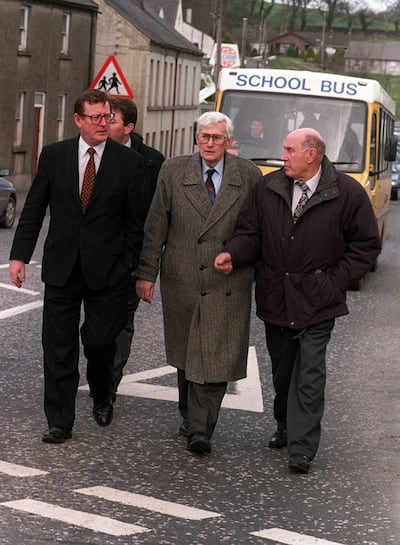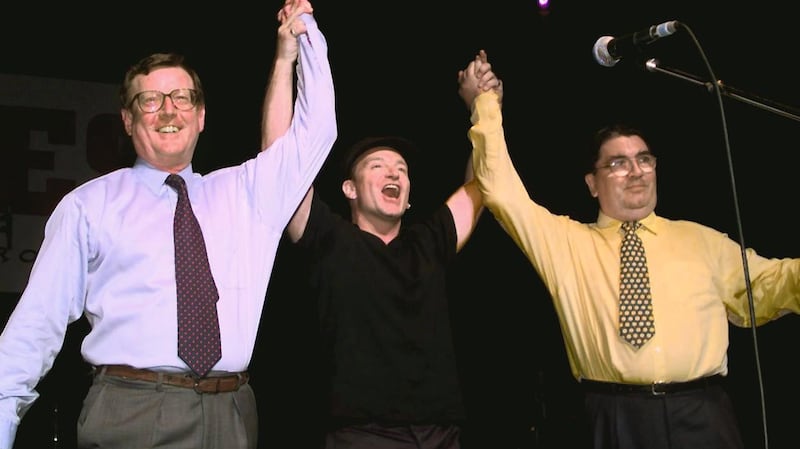A new RTÉ programme has highlighted how the murders of two best friends, a Catholic and a Protestant, helped galvanise politicians into ensuring that the Belfast Agreement negotiations would be successfully concluded.
The two-part documentary also addresses how the appearance of Bono with John Hume and David Trimble at a Belfast concert helped to energise the Yes referendum campaign for the agreement at a time when those promoting the deal feared the tide of public opinion was turning against them.
The programme running over Monday and Tuesday nights (April 3rd and April 4th) and presented by Miriam O’Callaghan and directed by Trevor Birney examines the fraught period of negotiations leading to the agreement on Good Friday 1998 and the campaign to have the deal publicly endorsed at the referendum the following month.
While quite a number of those centrally involved in the negotiations such as John Hume and David Trimble, Seamus Mallon and Mo Mowlam are dead, the documentary, called The Agreement, features many other key participants such as George Mitchell, Bertie Ahern, Tony Blair, Bill Clinton, Jeffrey Donaldson and Gerry Adams.
RM Block
The Agreement refers to how on March 3rd, 1998 Loyalist Volunteer Force gunmen carried out an attack on a pub in Poyntzpass, Co Armagh killing Philip Allen and Damien Trainor. They were best friends, respectively one a Protestant, the other a Catholic.

They were having a drink of orange juice in the Railway Bar, where Mr Allen had asked Mr Trainor to be best man at his wedding, when the gunmen struck.
The DUP leader, Mr Trimble, and SDLP deputy leader Seamus Mallon visited the two families together. This was during a difficult period of the negotiations. Former SDLP leader and finance minister in the first Northern Executive Mark Durkan told the programme how the nature of the men’s friendship and the image of a unionist and nationalist leader coming together to show their revulsion spurred politicians to make that extra effort to get a deal done.
He said politicians from every party demonstrated “a real resolve that violence like that wasn’t going to be seen to have the upper hand over the sort of dialogue we were trying to be involved in”.
“I remember saying that day the stories we were hearing on the radio about their friendship could be a parable for the sort of society that we could get if we got an agreement,” an emotional Mr Durkan told the programme.
“There was real determination that day being voiced by the parties, that even though we were still in disagreement about different things or whatever, but there was a determination there that we couldn’t just let these talks drift into failure,” he said.
Mr Durkan also explained how the images that day prompted the idea of how, as happened, the positions of first minister and deputy first minister should be a joint office: “When I subsequently that day saw the pictures on TV of Seamus Mallon and David Trimble together in Poyntzpass it registered in my mind that you can have a leader of nationalism and a leader of unionism almost literally binding the wounds of the community. That turned into the idea of a joint office of first ministers.”
David Kerr, who was the Ulster Unionist Party director of communications at the time, said he always felt that Mr Trimble and Mr Mallon “came back from that tragedy totally united and at one”.
“Spiritually, ideologically they were going to do something with the process. They were going to work as hard as they could to get some kind of a political breakthrough to stop these sorts of things happening because we just lived with this all our lives. We’d live with this for years and years and years. It had to stop,” he said.
Mr Kerr also referred to how the joint appearance of Mr Hume and Mr Trimble in the Waterfront Hall with Bono helped sway some doubting public opinion in the run-up to the referendum. He explained how the appearance from prison of the so-called IRA Balcombe Street bombers at the Sinn Féin Ardfheis in Dublin and also loyalist prisoner Michael Stone being allowed out to attend a loyalist rally in the Ulster Hall in Belfast had played badly with a lot of the public, particularly with unionists.

He said those battling in favour of the agreement were being hit with a “pretty relentless sort of tidal wave of negative publicity” and something was needed to “reboot” the Yes campaign.
Former SDLP councillor Tim Attwood, who had the brainwave of asking U2 to play at the Waterfront Hall, said an image was needed “showing that this place can work”.
The Northern Ireland band Ash also played to provide North-South balance. Mr Attwood and Mr Kerr explained how prior to the concert Bono asked Mr Hume and Mr Trimble to do something on stage they weren’t used to: to say nothing.
Bono introduced “two men who are making history, two men who have taken a leap of faith out of the past and into the future” while raising aloft the hands of the two leaders. It was an image of unity that was transmitted around the world.
It “gave a huge energy and lift” to the campaign, said Mr Attwood. “Everything brightened up,” said Mr Kerr.
Mr Kerr said it was a pivotal moment in the campaign, helping ensure a very high 81 per cent turnout, and a 71 per cent vote in favour of the agreement. “So that was what did it. We needed this. We needed this event. It doesn’t mean it works in every context. It doesn’t mean you wheel out celebrities every time there’s a political crisis in any country, but with that particular moment in time, and that moment in history, it just captured it. We’ll never see the likes of it again.”
During the programme former Sinn Féin president Gerry Adams said: “The agreement was never a settlement. It’s an agreement on a journey, without agreement on a destination.”
The talks’ chairman, the former US senator George Mitchell, said the “most gratifying” thing about his many years in Northern Ireland was in the numbers. “In the 25 years preceding the agreement 3,500 people in Northern Ireland were killed and an estimated 50,000 were injured. In all the years since the agreement the total number of violent deaths is about 145.”
* The two-part series The Agreement is broadcast on RTÉ One on Monday, April 3rd (9.35pm) and Tuesday, April 4th (10.15pm)
















